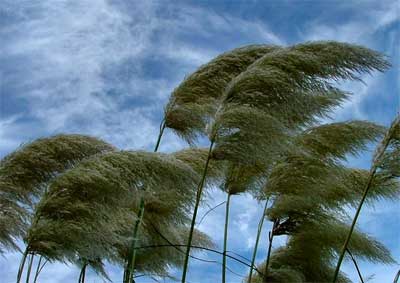 Given that California is currently experiencing some massive windstorms, we thought that we would provide you with some tips for playing tennis in the wind or using it to your advantage:
Given that California is currently experiencing some massive windstorms, we thought that we would provide you with some tips for playing tennis in the wind or using it to your advantage:
1. Since drilling in the wind is frustrating, windy conditions are great for playing points. Therefore, rather than performing repetition-type drills, find someone to play sets against and use it to get better.
2. Wind requires even better footwork than usual. The ball tends to swirl around until the very last second so it's important for you to constantly strive to position yourself for the optimal shot.
3. This may be obvious, but try not to aim for the lines (or even inside the lines). If you aim for the lines and the ball is moved by the wind in a ten foot radius, there is a great likelihood that you're going to miss. Instead, aim for the middle of the court and have the wind move the ball for you. That same 10ft radius will be inside the lines.
4. Even if it's not natural for you, try to approach the net (either serve and volley, chip and charge or off a ground-stroke). It's difficult to be precise in the wind so your opponents will have a more difficult time trying to pass you. On the other hand, you will be better positioned to knock balls down into the opponent's court and, therefore, not be affected by the conditions.
5. Use slices for two major reasons: (A) your opponent will have to bend her knees and move her feet even more than usual increasing the chances that she will miss (hitting a skidding ball is hard enough under normal conditions); and (B) slices (well-struck ones, anyway) tend to not have such a high arc when crossing the net - therefore, the wind will not have the opportunity to affect such shots. As always, however, don't attempt this shot for the first time in a match and under windy conditions. Practice, practice, practice beforehand.
6. Not aiming for the lines is not just for groundstrokes but also for the serve. The kick-serve and slice serve are probably your best bet under these conditions. First of all, determine which one of your serves requires a lower toss - that should be your "A" serve. As above, a lower toss has less chance of being affected by the wind. Once you figure out this aspect, make just slight adjustments to vary the intended target - the wind will take care of the rest (the ball will "sail" with the direction of the wind). For example, slice/kick down the T, middle of the court, or out wide. Sometimes, it also helps to be sneaky - by not putting a lot of pace/spin on the ball, the wind will play with it, making it swirl and, consequently, difficult and frustrating to return. When hitting serves against the wind, we have found that a slice serve tends to penetrate better than a kick or flat serve. When the wind is behind you, try to kick the serve more so that the ball explodes on your opponent and he has trouble generating pace from above his shoulders.
7. If you know that your opponent has trouble with "dinkers" under normal conditions, these problems will be magnified by the wind. Don't rip the ball with a lot of spin (since such shots will penetrate the wind and will be easier to handle); use only enough pace and spin to maintain proper ball control. Give your opponent a wobbly ball to hit against and allow him to self-destruct.
8. Remember the "10 and under play" or the sneak-attack. This is where you lob a high-topspin ball and, while your opponent is backing up and trying to figure out how to best handle it, you sneak in (wind may drown out your footsteps) and knock your opponent's shot out of the air. It works once in a while, particularly against some inexperienced players who back up for every ball.
9. Keep tabs of the shift in wind; check out the swaying of the trees, blowing of the dust, or puffing of the net or windscreens. Remember to make proper adjustments when changing sides. If, on one side, you're facing the wind, chances are that you will be over-hitting when you change ends. Therefore, remember to add more spin. Conversely, when you change from side where the wind was behind you to one where it is in front, add more pace.
In addition, if the court has a drainage "tilt" (which can either be side-to-side or end-to-end, depending on the set-up of the facility), it may be exacerbated by the wind; see if you can use it to your advantage by sliding the ball with the wind into the low part of the court and having your opponent get even more out of position.
10. Wind may be beautiful for sailing but when it comes to tennis it's all ugly. Therefore, expect to play ugly and win ugly. Under these conditions, it's all about getting the job done, not making the highlight reel.